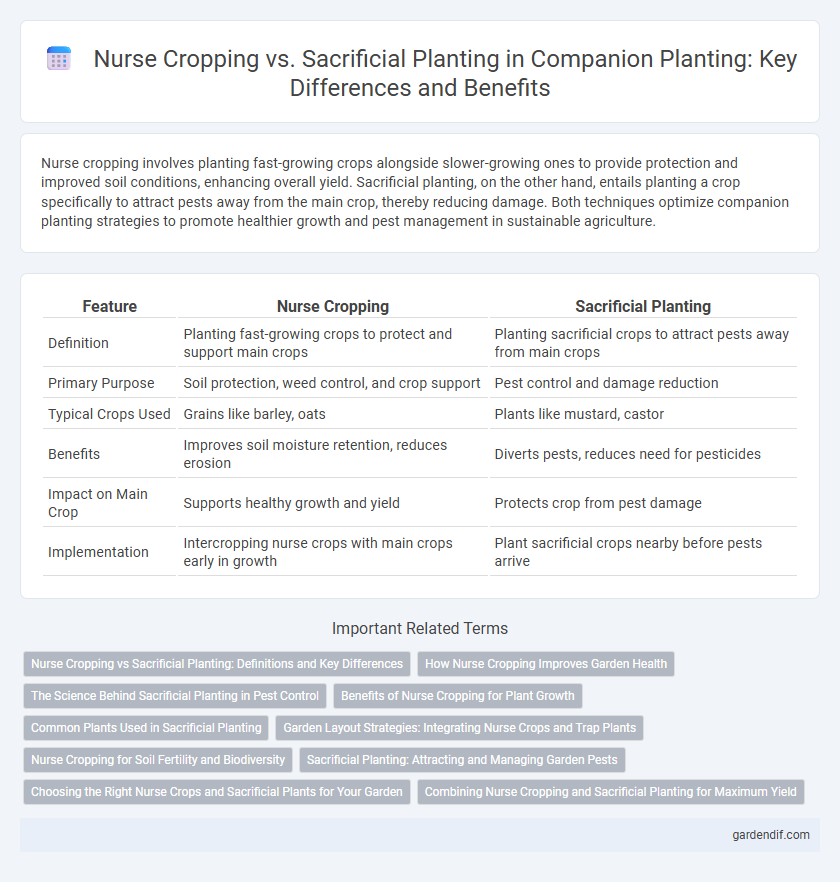
Nurse cropping vs sacrificial planting Illustration
Nurse cropping involves planting fast-growing crops alongside slower-growing ones to provide protection and improved soil conditions, enhancing overall yield. Sacrificial planting, on the other hand, entails planting a crop specifically to attract pests away from the main crop, thereby reducing damage. Both techniques optimize companion planting strategies to promote healthier growth and pest management in sustainable agriculture.
Table of Comparison
| Feature | Nurse Cropping | Sacrificial Planting |
|---|---|---|
| Definition | Planting fast-growing crops to protect and support main crops | Planting sacrificial crops to attract pests away from main crops |
| Primary Purpose | Soil protection, weed control, and crop support | Pest control and damage reduction |
| Typical Crops Used | Grains like barley, oats | Plants like mustard, castor |
| Benefits | Improves soil moisture retention, reduces erosion | Diverts pests, reduces need for pesticides |
| Impact on Main Crop | Supports healthy growth and yield | Protects crop from pest damage |
| Implementation | Intercropping nurse crops with main crops early in growth | Plant sacrificial crops nearby before pests arrive |
Nurse Cropping vs Sacrificial Planting: Definitions and Key Differences
Nurse cropping involves planting a temporary crop that protects and enhances the growth of a main crop by improving soil conditions and providing shade, while sacrificial planting deliberately sacrifices one crop to divert pests away from a more valuable main crop. Nurse crops mainly aid in reducing soil erosion and retaining moisture, whereas sacrificial plants act as traps to protect the main crop from pest infestation. The key difference lies in nurse crops supporting overall crop health, whereas sacrificial planting prioritizes pest control through strategic crop loss.
How Nurse Cropping Improves Garden Health
Nurse cropping enhances garden health by providing ground cover that reduces soil erosion and retains moisture, creating a favorable microenvironment for main crops. This practice supports beneficial insect populations and suppresses weed growth, leading to a balanced ecosystem. It also improves soil fertility through nitrogen fixation and organic matter accumulation, promoting sustainable garden productivity.
The Science Behind Sacrificial Planting in Pest Control
Sacrificial planting leverages specific plants to attract pests away from valuable crops, effectively reducing pest populations through targeted biology and chemical signaling. This method exploits pest behavior and plant chemistry, making it a strategic, eco-friendly pest management approach in companion planting systems. The science behind sacrificial planting focuses on understanding plant volatile compounds that lure pests, enabling growers to protect main crops without harmful pesticides.
Benefits of Nurse Cropping for Plant Growth
Nurse cropping enhances plant growth by providing protective shelter and microclimate regulation, reducing wind erosion and temperature extremes for young seedlings. This method also improves soil fertility through nutrient cycling and organic matter addition, promoting robust root development. Compared to sacrificial planting, nurse cropping offers sustainable benefits like weed suppression and moisture retention, fostering healthier and more resilient crops.
Common Plants Used in Sacrificial Planting
Common plants used in sacrificial planting include mustard, marigold, and radish, which effectively attract pests away from main crops by serving as trap plants. These plants are deliberately sown to lure harmful insects, reducing pest damage on valuable vegetables like tomatoes and beans. Incorporating sacrificial plants enhances integrated pest management by promoting a healthier and more balanced garden ecosystem.
Garden Layout Strategies: Integrating Nurse Crops and Trap Plants
Nurse cropping and sacrificial planting serve distinct roles in companion planting, enhancing garden resilience through strategic layout design. Nurse crops provide a protective microenvironment, fostering seedling growth by moderating temperature and retaining soil moisture, while sacrificial or trap plants divert pests away from primary crops, reducing damage and promoting healthier yields. Integrating both approaches in garden layout involves positioning nurse crops to shield vulnerable plants and installing trap plants at borders or high-risk zones to intercept pests, optimizing spatial use and ecological functions for sustainable pest management and plant health.
Nurse Cropping for Soil Fertility and Biodiversity
Nurse cropping enhances soil fertility by providing protective cover that reduces erosion, increases organic matter, and promotes beneficial microbial activity. This practice supports biodiversity by creating a habitat for a variety of insects and organisms, improving overall ecosystem resilience. Compared to sacrificial planting, nurse cropping integrates companion plants that actively contribute to nutrient cycling and soil health without compromising primary crop yield.
Sacrificial Planting: Attracting and Managing Garden Pests
Sacrificial planting involves strategically growing certain plants to attract and divert garden pests away from valuable crops, effectively serving as a pest management tool. This method reduces the reliance on chemical pesticides by providing an alternative food source for insects, thereby protecting companion plants and improving overall garden health. By carefully selecting sacrificial plants that are highly attractive to specific pests, gardeners can manage infestations and maintain ecological balance within the garden environment.
Choosing the Right Nurse Crops and Sacrificial Plants for Your Garden
Selecting the right nurse crops and sacrificial plants involves considering soil type, climate, and target crop requirements to maximize growth and pest control. Fast-growing nurse crops like clover or rye provide ground cover and nitrogen fixation, enhancing soil fertility while protecting young plants. Sacrificial plants such as marigolds or nasturtiums attract pests away from valuable crops, reducing damage and maintaining garden health.
Combining Nurse Cropping and Sacrificial Planting for Maximum Yield
Combining nurse cropping and sacrificial planting enhances crop resilience and maximizes overall yield by providing early-season protection and suppressing weed growth around the main crop. Nurse crops establish quickly, shielding young plants from environmental stress, while sacrificial plants draw pest attention away from valuable crops, reducing damage and nutrient competition. Integrating these methods optimizes resource use, promotes healthier crop development, and increases harvest efficiency in diverse agricultural systems.
Nurse cropping vs sacrificial planting Infographic

 gardendif.com
gardendif.com